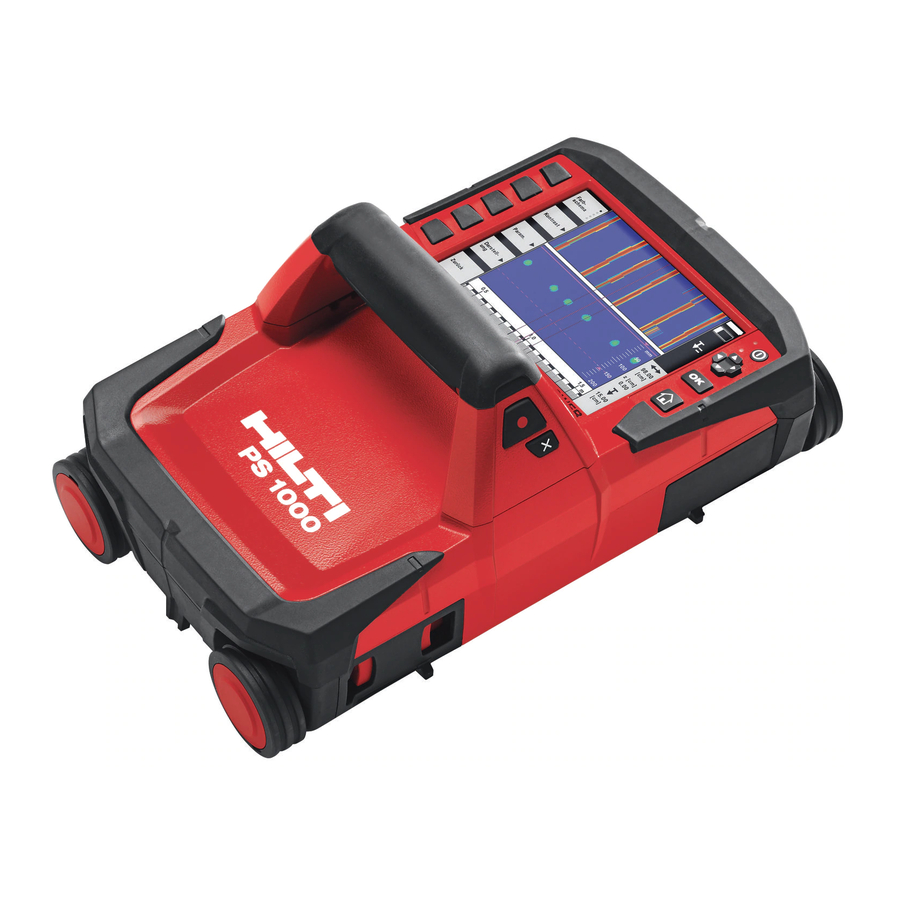
Hilti PS 1000 X-Scan Tips And Tricks Manual
Radar detection system
Hide thumbs
Also See for PS 1000 X-Scan:
- Operating instructions manual (38 pages) ,
- Operating instructions manual (243 pages)
Table of Contents
Advertisement
Tips & tricks
Scanning on rough surfaces
When the scanner is moved over a rough surface, the distance between the scanner and the
surface beneath doesn't remain constant. The position and depth readings obtained are thus
inaccurate. Measurement errors of this kind can be avoided by placing a thin sheet of suitable
material (e.g. wood, cardboard, etc.) on this rough surface.
The thickness of the sheet must be taken into account when interpreting the scan.
Scanning beams and columns
The reinforcement in beams and columns may be located very close to the edges.
As the scanner should never be lifted away from the surface when a scan is in progress, i.e. all
4 wheels must stay in contact with the surface at all times, sheets of a suitable material should
be positioned so that they project beyond the edges of the surface to be scanned. Objects
positioned close to the edge of a beam or column may be indicated less clearly than objects
positioned further from the edge due to the weaker signal received.
The thickness of the sheet must be taken into account when interpreting the readings from the
scan.
Transferring data from the scanner to the monitor
Scan data can be transferred from the scanner to the monitor in various ways.
1.) The PSA 50 / 51 data cable can be used to transfer data between the monitor and the
scanner. This feature is not available with the Hilti PS 1000-B X-Scan.
2.) Alternatively, scan data can be saved on an SD card (PSA 95) and transferred directly to a
PC or to the monitor unit using the PSA 96 card reader.
Transferring data from the scanner to a PC
To transfer scan data from the scanner to a PC, you require an SD card (PSA 95) and a
PSA 96 card reader.
• First insert the SD card in the memory card slot on the scanner.
• All scan data will then be copied automatically to the SD card from the scanner's internal
memory.
• The card reader can then be connected to the USB interface on the PC and the data
subsequently transferred.
Caution: To avoid data loss, always make sure that the scanner is switched off before
inserting or removing the SD card.
Hilti PS 1000 X-Scan
tips & tricks
V 1.0 I 05/2011
Advertisement
Table of Contents

Summary of Contents for Hilti PS 1000 X-Scan
- Page 1 1.) The PSA 50 / 51 data cable can be used to transfer data between the monitor and the scanner. This feature is not available with the Hilti PS 1000-B X-Scan. 2.) Alternatively, scan data can be saved on an SD card (PSA 95) and transferred directly to a PC or to the monitor unit using the PSA 96 card reader.
- Page 2 Hilti PS 1000 X-Scan tips & tricks V 1.0 I 05/2011 Detecting steel rebars beside PVC pipes If PVC pipes are positioned relatively close to steel rebars, the PVC pipes detected will be shown on the screen much less clearly than the rebars., The contrast must thus be increased when evaluating the scan in order to make the PVC pipes more easily visible.
- Page 3 Tip: The Hilti PX 10 Transpointer can be used to transfer the position of the first scan to the opposite side of the wall on the basis of reference grid.
- Page 4 Hilti PS 1000 X-Scan tips & tricks V 1.0 I 05/2011 Calibrating detection results For technical reasons, depth readings from objects located by scanners employing the radar principle are generally not very accurate as long as the concrete permittivity is unknown. In ∆...
- Page 5 When possible, structures such as this should be scanned from both sides. Tip: Try two different permittivity values (in the settings under “Concrete”) when using Hilti PROFIS PS 1000 to analyze the scan results. An insulating layer consisting of a metallic material always causes strong signal reflection.
- Page 6 Using the scanner without the grip The grip of the Hilti PS 1000 X-Scan can be removed in order to allow use of the scanner on surfaces where installations such as pipes etc. present an obstacle.







Need help?
Do you have a question about the PS 1000 X-Scan and is the answer not in the manual?
Questions and answers